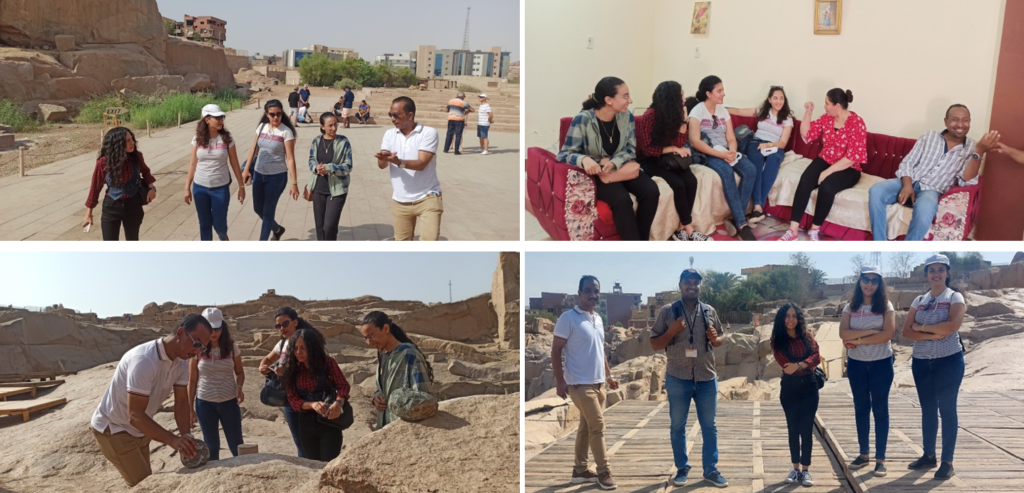Summer Training 2022 at the Nubia Museum (Yasser Abdelrady, Egypt, ITP 2019)
Written by Yasser Abdelrady, Conservator, Nubia Museum (Egypt, ITP 2019)
The Nubia Museum organised the Summer Training 2022 for the faculties of Archeology and Tourist Guidance undergraduate students. This year it was held from 29th June to 25th August 2022, two days a week, at the Conservation Department.
The training covered a number of theoretical and practical topics and field visits. In the beginning the participant students started getting to know each other, their professional interests, personal hobbies and their field of study. The training started with a theoretical lecture on the effects of light on archaeological artefacts. Then a field training and a tour in the temporary exhibition hall focused on the effect of the light on the displayed objects.

There was also a lecture about preventive conservation at the museums. The students had the chance to have a look at samples of some preserving and storing archival document files and boxes, and understand how to prepare them in the lab. Furthermore they also could understand the temperature and Relative Humidity monitoring of the display cases.

The training included a field tour of the Dr. Rageh Zaher Documentation Center. The students got a brief introduction about the center’s objects and the methods and techniques used in preserving archival documents, followed by a theoretical lecture on the traditional paper manufacture in the past and a showing of the samples of boxes used in preserving archival documents and how to prepare them at the labs and a practical application for preparing small models of the folders used in preserving archival documents at the laboratory.

The training activities also included completing a field tour of the exhibition halls of the museum and getting to know a number of the museum’s objects. As well as identifying some of the devices and instruments used to monitor and record temperatures and relative humidity, and learn how to operate it and interpret the resulting recorded sheet. Beside that, practical training in measuring the intensity of illumination using lux meters and identifying the appropriate lighting intensity for artefacts.

The activities included training on preparing boxes for preservation, packaging and storage of antiquities applied on educational models by using local materials for training.

The events dealt with a lecture for identifying some deterioration aspects of books and practical training to identify the components of old books, their structural composition, methods of preparing it by traditional methods.

The training activities extended outside the labs, with work on documenting objects and preparing a condition report. After that, there was practical training on the process of cleaning artefacts and documentation of the various steps of conservation processes.
The activities extended to outside the Museum, with a field visit to the archaeological area of the Elephantine Island, where the Aswan Museum annex was visited and we were accompanied during the visit by Mr. Mustafa Hassan Khalil – the Director of Aswan Museum, in which he explained the history of the establishment of the museum and the stages it has gone through until now. As well as the history of the annex to the museum and an explanation of its objects.

The visit was also joined by Mrs. Asmaa Siddik – Chief Inspector of Antiquities of Elephantine Island, where the students got a brief introduction to the area historically and archaeologically and the island’s contents of antiquities.

A field visit was also organised to the archaeological area of the unfinished obelisk, where the documentary film of obelisk making was watched in the lecture hall of the unfinished obelisk. Then they visited the site of the unfinished obelisk, accompanied by Mr. Haitham Muhammad Abdul-Mutaal, the obelisk antiquities inspector, where the students got a brief introduction about the historical and archaeological quarry of the obelisk, the methods of manufacturing the obelisk, and how to transport and erect it. After that the group was hosted by colleagues of the conservation department of the unfinished obelisk archaeological area.

Then the training activities returned to the Nubia Museum for identifying some of the devices in the laboratories of the conservation department. Then the students completed a questionnaire about the effectiveness of the training and the extent to which they benefited from it and some observations from their point of view. Then, museum tours resumed in the exhibition halls of the museum, where an explanation of the exhibition halls’ objects was completed.

At the last day, the Nubia Museum hosted Ms. Heba Al Derss Mohamed – Inspector of Antiquities of Aswan Museum to give a lecture entitled People Nature Culture “PNC22 – Korea” and an overview of South Korea’s World Heritage Sites. This is based on her experience and attendance of the training course: World Heritage Management People Nature Culture “PNC22”), which was held in South Korea from 1st to 12th August 2022, In order to achieve the greatest possible benefit for students enrolled in the summer training.

In the presence of Mr. Ahmed Abd el- Rahman – General Director of the Nubia Museum and Mr. / Mustafa Hassan Khalil – General Director of the Aswan Museum, agents and head of the conservation Department of the Nubia Museum, and a number of inspectors of Aswan and Nubia archaeological area, the certificates of thanks and attendance were given to the participants and some photos were taken.


Finally, I would like to thank the Head of the Conservation Department and the Director of the Nubia Museum for supporting me, and I would like to thank the colleagues who were mentioned above for their fruitful cooperation, and all my best wishes for the students enrolled in the summer training 2022 in their scientific and professional lives.

Yasser.
